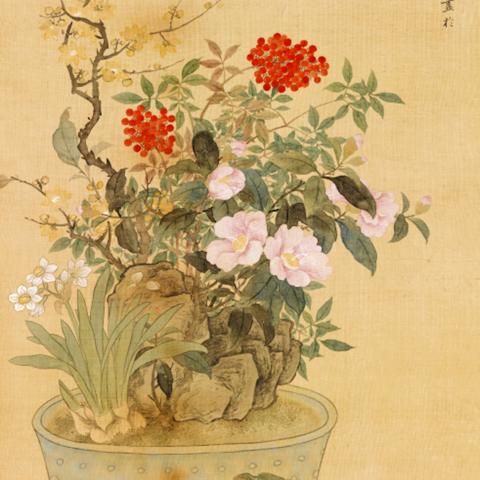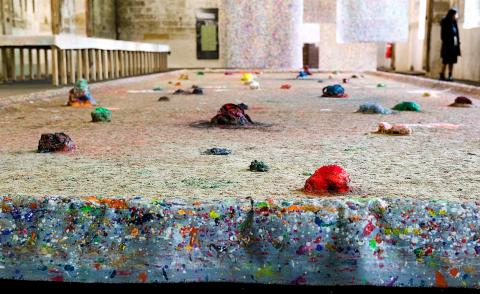Running concurrently with the 2018 Taichung World Flora Exposition is National Palace Museum’s flower- themed Pure Offerings of a Myriad Plants: Paintings on Flower Vases and Potted Scenes (百卉清供-瓶花與盆景畫特展). The exhibition features 42 paintings that shed light on the Chinese tradition of bonsai and floral arrangement. According to the museum, the art of vase flowers began some time between the Six and the Tang dynasties, mainly in the context of offering flowers to the Buddha. In the Song and Yuan dynasties, there was an increase of floral types available as methods of cultivation matured. During this time, the art of ceramics and the arrangement of flowers and branches also flourished and continued to develop into more refined literati aesthetics in the Ming and Qing dynasties. “Flower vases and potted scenes present viewers with ‘a world in a flower, a Buddha in a leaf,’ reflecting great observation and creativity as well as the rich symbolic content of traditional customs,” writes the museum. The show not only promotes the artistic merit of plant and flower paintings, it also hopes to encourage contemplation of how to live in harmony with nature.
■ National Palace Museum (國立故宮博物院), 221 Zhishan Rd Sec 2, Taipei City (台北市至善路二段221號), tel: (02) 2881-2021. Open daily from 8:30am to 6:30pm; closes at 9pm on Fridays and Saturdays
■ Until Dec. 25

Photo Courtesy of National Palace Museum
This weekend, C-LAB opens its second inaugural exhibition, Re-Base: When Experiments Become Attitude (再基地:當實驗成為態度), which is curated by Wang Chun-Chieh (王俊傑). The curatorial direction seems to weigh heavily on defining C-LAB’s creative potential as a new art institution located in the former Taipei Air Force Base. Wang defines the site as a convergence point for cultural experimentation, where “pre-established functions of the space will be broken through and a new network of inter-connectivity created,” reads the exhibition press release. The 11 artists and groups participating in the show work in different capacities, including visual, conceptual, performance, literary and new media arts. All works are site-specific and inspired by the space. Award-winning poet Hsia Yu (夏宇) presents 19 pieces of poetry by a large scrolling marquee and a series of “badly-taken” travel photos. A curtain of water separates the viewer from the work, creating an additional aesthetic layer. SLEEP 79 , by London-based artists Cheang Shu-lea (鄭淑麗) and Mathew Fuller, is a 79 day project that has invited a number of local artists, architects, shops and scholars to respond to the aesthetics of sleep.
■ C-LAB (臺灣當代文化實驗場), 177, Jianguo S Rd Sec 1, Taipei City (臺北市建國南路一段177號), tel: (02) 8773-5087. Open Tuesdays to Sundays from 10am to 6pm
■ Until Jan. 27

Photo Courtesy of TKG Plus
Supported by the Italian Economic, Trade and Cultural Promotion Office, IN BALANCE: Taiwan-Sicily (島嶼之間|臺灣 西西里文化藝術交流展) is a traveling exhibition of nine Taiwanese and seven Sicilian artists. The show debuted last month at Palazzo Borromeo in Milan, Italy, where it was seen by 50,000 visitors. This month, the show arrives in Taipei and will be on view at Gu Ju (谷居), G.Gallery (居藝廊) and the lobby of Hua Nan Commercial Bank Corporate Plaza. The exhibition aims to foster greater cultural exchange and public awareness of global issues concerning climate, religion, society, traditions and culture. Chou Ching-hui (周慶輝) is an award-winning photographer who focuses on the art of storytelling. Animal Farm is a five-year project that takes inspiration from zoos as a mirror of the state of modern life. Liao Chun-yu (廖俊裕) is a designer and illustrator involved in both commercial and fine arts. His black and white print, The Sea, depicts layers of waves stacked upon each other in interlocking motion. Liao’s work speaks to the Taiwanese admiration and curiosity of the sea, according to the organizer’s press release.
■ G.Gallery (居藝廊), B1, 3, Ally 3, Lane 227, Nongan St, Taipei City (台北市農安街227巷3弄3號B1), tel: (02) 2501-8326. Opens Wednesdays from 12pm to 7pm, and Thursdays to Sundays from 11am to 7pm; Gu Ju (谷居), 38, Ln 14, Dihua St Sec 1, Taipei City (台北市迪化街一段14巷38號), tel: (03) 526-3176. Open Tuesdays to Sundays 10am to 7pm
■ Until Nov. 25

Photo Courtesy of G.Gallery
Currently on view at TKG Plus is Thai artist Mit Jai Inn’s solo exhibition Light, Dark, Other. Mit Jai Inn is known for creating painting installations that involve clumps of oil pigment on untrimmed linen. The raw nature of his work “gives off a sense of wildness and freshness as well as the vibrant and saturated shades characteristic of the tropical rainforests,” writes the gallery in a press release. In addition to hanging his pieces on the wall and from the ceiling, Mit Jai Inn offers a tactile experience by placing his work on the ground so people can walk it. The process of creating these paintings is a laborious process of repeated mixing and applying the paint. The use of color, central to Mit Jai Inn’s practice, also carries political connotations that speak to the nation’s “changing cultural [and] political outcomes.” In addition to his personal work, the artist is also a member of Chiang Mai Social Installation, an artist collective that concerns itself with the politics of space by carrying out art actions in urban spaces.
■ TKG+ Projects, B1, 15, Ln 548, Ruiguang Rd, Taipei City (台北市瑞光路548巷15號B1), tel: (02) 2659-0798. Open Tuesdays to Sundays from 11am to 7pm
■ Until Nov. 25
Lightbox Photo Library and Voice of Photography magazine join forces for VOP Book Exhibition: Photobook As Method (攝影書作為方法). “We are currently in a golden era of photography books,” opens the exhibition preface, referring to the proliferation of independent publishing houses, art book fairs and photography festivals that have propped up all around the world. The exhibit showcases over 50 books in the Lightbox library that have been published since 2016. These books are also featured in the current issue of Voice of Photography in an effort to create a broad survey of the present state of local photography culture. Visitors are encouraged to cross-reference the magazine with the original books to understand the work and the magazine’s cultural context. The show also includes all 24 issues of Voice of Photography and a series of Taiwanese photography compilations published under the title Shout! Voice of Photography is an independent photography magazine and one of Taiwan’s important staples of art media.
■ Lightbox (Lightbox攝影圖書室), 3F, 1, Kinmen St, Taipei City (台北市金門街5-1號3樓). Open Tuesdays to Saturdays from 1pm to 8pm.
■ Until Nov 17

May 11 to May 18 The original Taichung Railway Station was long thought to have been completely razed. Opening on May 15, 1905, the one-story wooden structure soon outgrew its purpose and was replaced in 1917 by a grandiose, Western-style station. During construction on the third-generation station in 2017, workers discovered the service pit for the original station’s locomotive depot. A year later, a small wooden building on site was determined by historians to be the first stationmaster’s office, built around 1908. With these findings, the Taichung Railway Station Cultural Park now boasts that it has

Wooden houses wedged between concrete, crumbling brick facades with roofs gaping to the sky, and tiled art deco buildings down narrow alleyways: Taichung Central District’s (中區) aging architecture reveals both the allure and reality of the old downtown. From Indigenous settlement to capital under Qing Dynasty rule through to Japanese colonization, Taichung’s Central District holds a long and layered history. The bygone beauty of its streets once earned it the nickname “Little Kyoto.” Since the late eighties, however, the shifting of economic and government centers westward signaled a gradual decline in the area’s evolving fortunes. With the regeneration of the once

The latest Formosa poll released at the end of last month shows confidence in President William Lai (賴清德) plunged 8.1 percent, while satisfaction with the Lai administration fared worse with a drop of 8.5 percent. Those lacking confidence in Lai jumped by 6 percent and dissatisfaction in his administration spiked up 6.7 percent. Confidence in Lai is still strong at 48.6 percent, compared to 43 percent lacking confidence — but this is his worst result overall since he took office. For the first time, dissatisfaction with his administration surpassed satisfaction, 47.3 to 47.1 percent. Though statistically a tie, for most

In February of this year the Taipei Times reported on the visit of Lienchiang County Commissioner Wang Chung-ming (王忠銘) of the Chinese Nationalist Party (KMT) and a delegation to a lantern festival in Fuzhou’s Mawei District in Fujian Province. “Today, Mawei and Matsu jointly marked the lantern festival,” Wang was quoted as saying, adding that both sides “being of one people,” is a cause for joy. Wang was passing around a common claim of officials of the People’s Republic of China (PRC) and the PRC’s allies and supporters in Taiwan — KMT and the Taiwan People’s Party — and elsewhere: Taiwan and